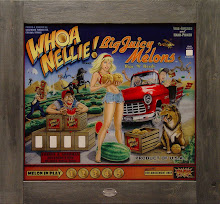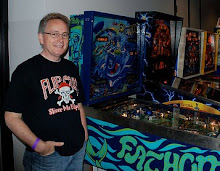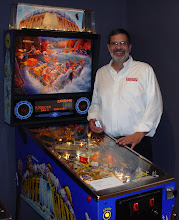
As we mentioned previously, Dennis bought the game in 2006 after seeing it at the art museum show in downstate Mt. Vernon, Illinois from local collectors Marvin and Jeff Giesting. Cosmetically the game was in great shape, including the backglass, but the game needed some work to get it back in playable condition. Unfortunately, when the game was delivered to Dennis, a mishap occurred in transit and the near mint condition backglass arrived broken into two pieces. Both Marvin and Jeff felt horrible about the glass and offered Dennis a discounted price for the game - a great example of the type of folks involved in the hobby of collecting pinball games. Dennis appreciated the generous offer and hoped he could find another backglass of similar quality. But who would have guessed that a few years later, the original backglass would no longer be needed.

After having stored the game since 2006, and never having spent any time with electro-mechanical games previous to this purchase, Dennis contacted Team EM, a group of pinball enthusiasts that specialize in EM games for some serious help. The closest team member geographically was Ken Walker so Dennis gave him a call to find out if he was interested in helping us look into the viability of the game. Ken agreed and we made a trip to his house with the CC game in the back of Dennis' pick-up.

Ken spent a good two hours with the game on a beautiful late summer afternoon on the patio in his backyard. After a brief overview of the game to help familiarize himself with the general condition, the game refused to start after we plugged it in so Ken started to diagnose the system to find the problem. As he moved through the game Ken explained to us the finer points of how an EM game works as he poked and prodded at different parts of the aging inner workings.


Dennis and I absorbed what we could from Ken's session, like a couple of dogs listening to human speech we were only understanding every fifth word or so, and soon realized that in the long run this step in the process was best left to the experts. I had never felt more comfortable or useful in my role as dedicated photographer.


One of the most interesting things we learned about these old games was the unusual method for turning them off. We found this label inside the cabinet and asked Ken to explain. Instead of an "off" switch all you have to do is kick the underside of the game and it will turn off. Apparently the fiction of the way Arthur Fonzarelli turned on or off the jukebox on Happy Days was based on some fact.

In a short period of time, Ken found the first suspect switch, adjusted it, and the game came to life for the first time since 2006. The lights were on, the flippers clacked and the bells dinged. He continued to inspect all apects of the game and in no time we were able to start playing.



I'm always amazed by mechanical aptitude because I believe I have a genetic flaw that prevents me from understanding how things work. Many people say, when it comes to art, they can't even draw a stick figure but put me in front of anything mechanical or electrical and what good is my stick figure? "Hey Stick, my car won't start...got any ideas?" I've spent many years around pinball machines but unfortunately I still have to call someone for almost any repairs.
After Ken finished his work, we packed the game back in the truck, thanked him for his guidance and expertise, and asked if he'd be available for future repair or diagnostics on an as-needed basis. Again he agreed to help us with any and all aspects of our project (he must have seen the lost look on our face during his diagnostic session). To show Ken the respect he deserves, here's a stick figure version of a new character I call..."Dr. Ken Walker, E-MD." Thanks again Ken!

In the next episode, Dennis begins the deconstruction and reconstruction process of Continental Cafe - the first step toward its new life as "Whoa Nellie! Big Juicy Melons".

All Photos on this post by G.Freres
Continental Cafe - Artwork by Roy Parker, Game Design by Wayne Neyens





















